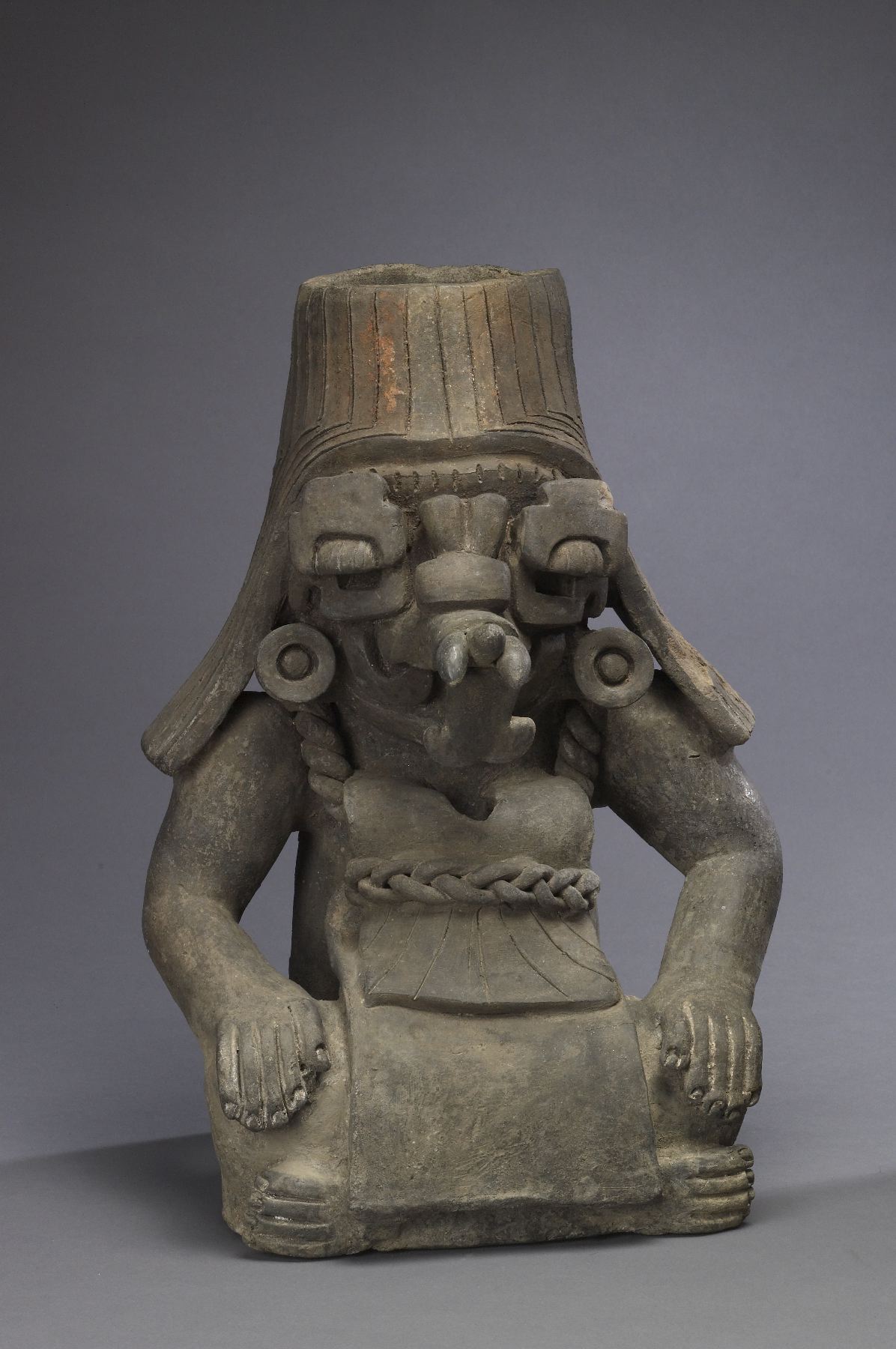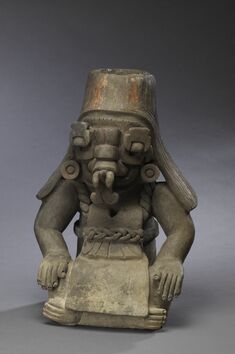Figural Urn
(Ancient Americas )
This urn likely was part of a larger grouping of similarly small figural sculptures surrounding a large one that created a ceramic narrative tableau like that of the famous royal Zapotec Tomb 104 at Monte Albán, Oaxaca. The urn portrays an impersonator of the Zapotec rain god Cociyo, here wearing a full face mask rather than the more common buccal (lower face, or mouth) mask. The figure's deeply striated hair was originally painted with what may have been an orange-hued pigment. In other renderings of these rain god impersonators, the hair is painted yellow, signifying maize silk. The same hairstyle, although unpainted, is also found on the large urn portraying the maize god (see TL.2009.20.293). This small figure wears a curious pectoral suspended by a thick twined rope around their necks. It may depict a folded piece of paper, cloth, or similarly malleable material tied with a braided band. In Zapotec tombs documented by archaeologists, small rain god urns have been found in sets of four placed around a large urn portraying the maize god/progenitor-ancestor. Such an arrangement replicates the five-fold Mesoamerican universe (the four cardinal directions plus the center), with the maize god/progenitor-ancestor as the axis mundi at the world's center, with its four sides defined by rain gods. The maize god at the center symbolizes the sacred mountain of origin from which all life emerged onto earth. The overarching narrative of these urn tableaux recounts the origin of the Zapotec people from maize and the seminal roles of the maize god Pitao Cozobi and the rain god Cociyo in Creation.
Provenance
Provenance (from the French provenir, 'to come from/forth') is the chronology of the ownership, custody, or location of a historical object. Learn more about provenance at the Walters.
Ron Messick Fine Arts, Santa Fe, New Mexico [date and mode of acquisition unknown]; John G. Bourne, 1990s, by purchase; Walters Art Museum, 2009, by gift.
Exhibitions
| 2012-2013 | Exploring Art of the Ancient Americas: The John Bourne Collection Gift. The Walters Art Museum, Baltimore; Frist Center for the Visual Arts, Nashville. |
| 1998-2008 | Art of Ancient America, 1500 B.C.-1400 A.D.. Museum of New Mexico, Santa Fe. |
Conservation
| Date | Description | Narrative |
|---|---|---|
| 1/1/2011 | Examination | How can you date ceramics? The object themselves give us the answer. The three Zapotec sculptures, Pitao Cozobi (Maize God) Impersonator Urn and the Cociyo (Rain God) Effigy Urns, were made of clay, which when fired, turned into ceramic. Small samples were taken from both urns and sent to Oxford University in England for thermoluminescence (TL) dating. The principle behind TL analysis is that specific minerals within clay absorb energy at a predictable rate. When the clay is fired, the minerals release all their energy. This sets the “TL clock” back to zero, and then once again the clay minerals begin to absorb energy. When we tested samples from these urns, the absorbed TL energy was released and measured. This told us how long it had been since the urns were last fired. The TL data show that the urns were, in fact, created between 1,200 and 1,900 years ago. |
Geographies
Mexico, Oaxaca (Place of Origin)
Measurements
H: 15 3/8 x W: 10 13/16 x D: 9 7/16 in. (39 x 27.4 x 23.9 cm)
Credit Line
Gift of John Bourne, 2009
Location in Museum
Not on view
Accession Number
In libraries, galleries, museums, and archives, an accession number is a unique identifier assigned to each object in the collection.
In libraries, galleries, museums, and archives, an accession number is a unique identifier assigned to each object in the collection.
2009.20.21





